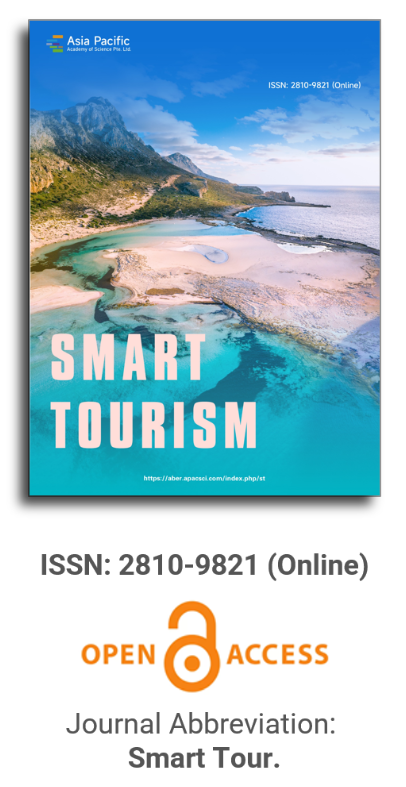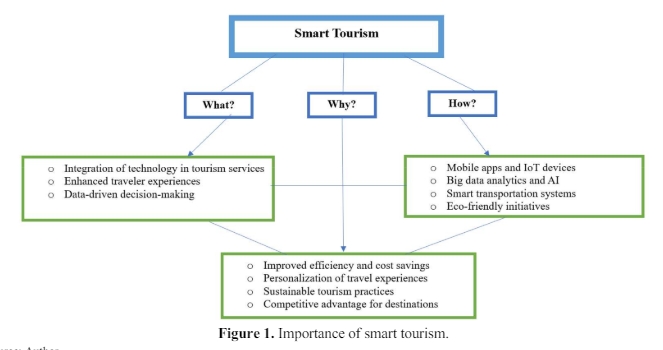


Smart tourism destination, physical experience and rural tourism
Vol 1, Issue 2, 2020
Download PDF
Abstract
The STD paradigm must consider the relevance of technology, not only as a management component, but also as an attribute of the tourist experience at the destination. The concept of physical experience is emerging as an important challenge for the design of each STD, and there may be relevant differences between types of destinations.
This paper studies the STD/Physical binomial as the case of the chicken and the egg. It is based on field work in a rural destination, and builds a model that defines and values the concepts of Utility and Value of Technology for its visitors, integrating the main current technological applications in the STD.
The results allow us to observe how mobile, online/ontime technology is a permanent part of the tourist behavior, and of the creation of a new type of personalized experience that.
Keywords
References
- Gretzel U, Sigala M, Xiang Z, et al. Smart tourism: Foundations and developments. Electronic Markets 2015; 25(3): 179–188.
- Li Y, Hu C, Huang C, et al. The concept of smart tourism in the context of tourism information services. Tourism Management 2017; 58: 293–300.
- Koo C, Shin S, Gretzel U, et al. Conceptualization of smart tourism destination competitiveness. Asia Pacific Journal of Information Systems 2016; 26(4): 561–576.
- Law R, Buhalis D, Cobanoglu C. Progress on information and communication technologies in hospitality and tourism. International Journal of Contemporary Hospital Management 2014; 26(5): 727–750.
- Volger M, Pechlaner H. Requirements for destination management organisations in destination governance: Understanding DMO success. Tourism Management 2014; 41: 64–75.
- Pike S. Tourism Destination branding complexity. Journal of Product & Brand Management 2016; 14(4): 258–259.
- Werther H, Koo C, Gretzel U, et al. Special issue on smart tourism systems. Computers in Human Behavior 2015; 50: 556–557.
- Ritzer G, Dean P, Jurgenson N. The coming of age of the prosumer. American Behavioral Scientist 2012; 56(4): 379–398.
- García M, Troitino L. The transformation of the historic city into a Smart tourism destination. In: CETT (Ed.), Smart Tourism Congress Barcelona 2016.
- Ivars JA, Solsona FJ, Giner D. Tourism management and information and communication technologies (ICT): The new approach to smart destinations. Documents d’Anàlisi Geogràfica 2016; 62(2): 327–346.
- Ivars JA, Celdrán MA, Femenia F. Guide for the implementation of smart tourist destinations in the Valencia community. Invat.tur-University Institute for Tourism Research 2017.
- Sheehan L, Vargas Sanchez A, Presenza A, et al. The use of intelligence in tourism destination, management: An emerging role for DMOs. International Journal of Tourism Research 2016; 18(6): 549–557.
- Rabariy C, Storper M. The digital skin of cities: Urban theory and research in the age of the sensored and metered city, ubiquitous computing and big data. Cambridge Journal of Regions, Economy and Society 2015; 8(1): 27–42.
- Gretzel U, Zhong L, Koo C. Application of smart tourism to cities. International Journal of Tourism Cities 2016; (3): 216–233.
- Boes K, Buhalis D, Inversini A. Smart tourism destinations: Ecosystems for tourism destination competitiveness. International Journal of Tourism Cities 2016; 2(2).
- Neuburger L, Beck J, Egger R. The ‘Physical’ tourist experience: The use of augmented and virtual reality in destination marketing. Tourism Planning and Destination Marketing Emerald Publishing Limited 2018; 183–202.
- Belghiti S, Ochs A, Lemoine JF, Badot O. The Physical shopping experience: An attempt at conceptualization and empirical investigation. In Academy of Marketing Science EWorld Marketing Congress Cham: Springer; 2017. p. 61–74.
- Gretzel U, Werthner H, Koo C, et al. Conceptual foundations for understanding smart tourism ecosystems. Computers in Human Behavior 2015; 50: 558–563.
- Buonincontri P, Micera R. The experience co-creation in smart tourism destinations: A multiple case analysis of European destinations. Information Technology & Tourism 2016; 16(3): 285–315.
- Wang X, Zheng X, Zhang Q, et al. Crowdsourcing in ITS: The state of the work and the networking. IEEE transactions on intelligent transportation systems 2016; 17(6): 159–165.
- Redondo M. Tourist 3.0 the travel experience matters most. Available from: https://cincodias.elpais.com/cincodias/2016/01/07/sentidos/
- González L. Five characteristics that differentiate the tourist 3.0; 2017. Available from: http://www.cognodata.com/notas_de_prensa
- Neuhofer B, Buhalis D, Ladkin A. Conceptualising technology enhanced destination experiences. Journal of Destination Marketing and Management 2012; 1(1–2): 36–46.
- Ballina F, Valdés L, Valle E. Discrimination of tourism behavior as a function of the technology used. Comparison between rural and urban destinations. In: I Seminario DIT 2017; 424–442.
- Coma J, Elorrieta B, Torres A. The incidence of ICT in Spanish mountain tourism destinations. A case analysis. ARA 2016; 6(2): 75–86.
- Martini U, Buffa F, Notaro S. Community participation natural resource management and the creation of innovative tourism products: Evidence from Italian networks of reserves in the Alps. Sustainability 2017; 9(2314): 1–16.
- Yang W, Mattila AS. Why do we buy luxury experiences? Measuring value perceptions of luxury hospitality services. International Journal of Contemporary Hospitality Management 2016; 28(9): 1848–1867.
- Chathoth PK, Ungson GR, Harrington RJ, et al. Co-creation and higher order customer engagement in hospitality and tourism services: A critical review. International Journal of Contemporary Hospital Management 2016; 28(2): 222–245.
- Buonincontri R, Morvillo A, Okumus F, Niekerk M. Managing the experience co-creation process in tourism destinations: Empirical findings from Naples. Tourism Management 2017; 62: 264–277.
- Gríssemann US, Stokburger NE. Customer co-creation of travel services: The role of company support and customer satisfaction with the co-creation performance. Tourism Management 2012; 33(6): 1483–1492.
- Howell RT, Pchelina P, Lyer R. The preference of experiences over possessions: Measurement and construct validation of the experiential buying tendency scale. The Journal of Positive Psychology 2012; 7(1): 57–71.
- Salvado J, Ferrerira A, Costa C. Co-creation: The travel agency’s new frontier. In Proceedings of the International Conference of Tourism, Management Studies; 2011. p. 229.
- Shaw G, Bailey A, Williams A. Aspects of service-dominant logic and its implications for tourism management: Examples from the hotel industry. Tourism Management 2011; 32(2): 207–214.
- Rodriguez NG, Alvarez BA, Vijande MLS. Service dominant logic in the tourism sector: Internal marketing as an antecedent of an innovation’s cocreation culture with clients and first-line employees. Cuadernos de Gestión 2011; 11(2): 53–75.
- Amaro S, Duarte P, Henriques C. Traveler’s use of social media: A clustering approach. Annals of Tourism Research, 2016; 59: 115.
- Usakli A, Koc B, Sonmez S. How social are Destinations? Examining European DMO social usage. Journal of Destination Marketing & Management 2017; 6: 136–149.
- Ladhari R, Michaud M. eWOM effects on hotel booking intentions, attitudes, trust, and website trust, and website perceptions. International Journal of Hospitality Management 2015; 46: 36–45.
- Vermeulen IE, Seegers D. Tried and tested: The impact of online hotel reviews on consumer consideration. Tourism Management 2009; 30(1): 123–127.
- Almeida A, Moreno S. New trends in information search and their influence on Destination loyalty: Digital destinations and relationship marketing. Journal of Destination Marketing and Management 2017; 65: 150–161.
- Munar AM, Jacobsen JKS. Motivations for sharing tourism experiences through social media. Tourism Management 2014; 43: 46–54.
- Sotiriadis MD. Sharing tourism experiences in social media: A literature review and a set of suggested business strategies. International Journal of Contemporary Hospitality Management 2017; 29(1): 179–225.
- Sheehan L, Vargas SA, Presenza A, et al. The use of intelligence in tourism destination management: An emerging role for DMOs. International Journal of Tourism Research 2016; 18(6): 549–557.
- Martini U, Buffa F, Notaro S. Community participation natural resource management and the creation of innovative tourism products: Evidence from Italian networks of reserves in the Alps. Sustainability 2017; 9(2314): 1–16.
Supporting Agencies
Copyright (c) 2020 Francisco J. Ballina Ballina
License URL: https://creativecommons.org/licenses/by/4.0/

This site is licensed under a Creative Commons Attribution 4.0 International License (CC BY 4.0).

Prof. Hung-Che Wu
Nanfang College, Guangzhou
China
Indexing & Archiving
Asia Pacific Academy of Science Pte. Ltd. (APACSCI) specializes in international journal publishing. APACSCI adopts the open access publishing model and provides an important communication bridge for academic groups whose interest fields include engineering, technology, medicine, computer, mathematics, agriculture and forestry, and environment.



.jpg)
.jpg)

.jpg)

